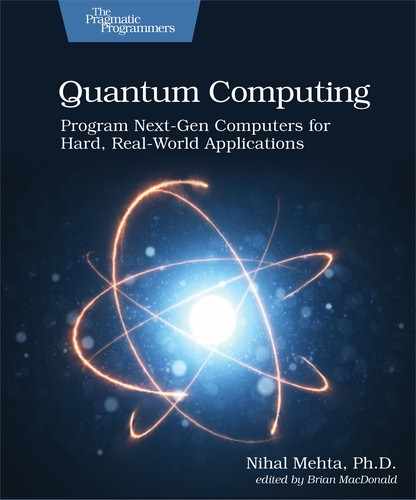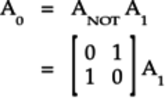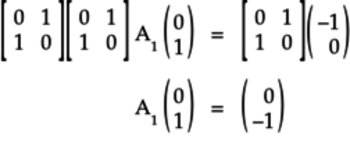Two-Qubit Gate Matrices
Just as the columns of a single-qubit gate matrix
correspond to the idealized states, the columns
of a matrix representing a two-qubit gate,
such as the Controlled NOT (CNOT) Gate,
correspond to the four idealized states—![]() ,
,
![]() ,
, ![]() , and
, and
![]() — for two qubits:
— for two qubits:
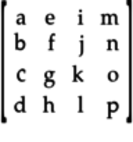
The letters ![]() are complex numbers
with the usual conjugates
are complex numbers
with the usual conjugates ![]() .
.
Each column is the action of the gate on the
idealized state associated with that column.
For example, look at the Controlled NOT (CNOT) Gate
gate in which the control qubit is
set to ![]() and its
target to
and its
target to ![]() ,
as shown in the following figure:
,
as shown in the following figure:

Because the control is ![]() ,
the target qubit is switched to
,
the target qubit is switched to
![]() .
.
Or, the ![]() state is changed by the
CNOT gate to the
state is changed by the
CNOT gate to the ![]() state. To express this operation as a matrix column,
write the latter as a vector:
state. To express this operation as a matrix column,
write the latter as a vector:

Thus, the third column of the matrix ![]() for the CNOT gate is:
for the CNOT gate is:
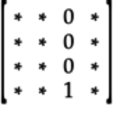
Similarly, you can fill the other columns:
- CNOT acts on

-
When the control qubit is
 , the target
qubit continues to be
, the target
qubit continues to be  .
Thus,
.
Thus,  or:
or:

- CNOT acts on

-
Since the control qubit is
 , the target
qubit is unaffected and continues to
, the target
qubit is unaffected and continues to  .
Thus,
.
Thus,  or:
or:

- CNOT acts on

-
In this case, the control qubit is
 . So, the target
qubit switches from
. So, the target
qubit switches from  to
to
 . Thus,
. Thus,
 or:
or:
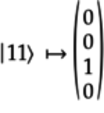
Putting these vectors as the appropriate columns in
the previous matrix, we’ll get the CNOT
gate’s matrix ![]() :
:

Notice that we’ve suppressed the column labels, but you should still associate each column with the corresponding idealized states.
Following the same line of reasoning, you can derive
the gate matrix ![]() for the
Controlled Z (CZ) Gate. The CZ
gate only rotates the triangle
for the
Controlled Z (CZ) Gate. The CZ
gate only rotates the triangle ![]() qubelet on the target qubit when the
control bit is
qubelet on the target qubit when the
control bit is ![]() ,
as shown in the following figure:
,
as shown in the following figure:

That is, the state ![]() becomes
becomes
![]() . Writing the latter as
a vector:
. Writing the latter as
a vector:
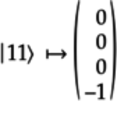
The CZ gate leaves the other idealized states alone. Or, in terms of vectors:

In the first two instances, the control
qubit is ![]() . Thus, the target
qubit is unchanged. In the last case, even though the
control qubit is
. Thus, the target
qubit is unchanged. In the last case, even though the
control qubit is ![]() ,
the target qubit is
,
the target qubit is ![]() and
not affected by the CZ gate.
and
not affected by the CZ gate.
These vectors form the rest of the columns of the
CZ gate’s matrix ![]() :
:
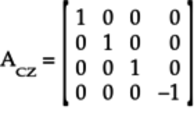
With matrices for two-qubit gates, you can follow the procedure in Sequence of Gates as Matrix Multiplication, to work out how circuits with two-qubit gates modify quantum states. For example, see the following circuit:
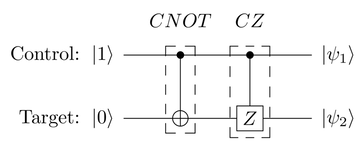
Obtain the two-qubit quantum state ![]() as follows:
as follows:

Notice the order of the multiplication of the
![]() and
and ![]() matrices
is reverse that of the order in which the corresponding
gates are applied to the input state
matrices
is reverse that of the order in which the corresponding
gates are applied to the input state
![]() in the quantum circuit.
Also, in the previous equation, the input state
in the quantum circuit.
Also, in the previous equation, the input state
![]() is replaced with a
vector which has a 1 in the third
element, corresponding to
is replaced with a
vector which has a 1 in the third
element, corresponding to ![]() .
.
The result of this multiplication is a vector
whose last element is ![]() . The bottom
element is associated with the quantum state
. The bottom
element is associated with the quantum state
![]() . So, a
. So, a ![]() value indicates that this sequence of gates changes the
quantum state as follows:
value indicates that this sequence of gates changes the
quantum state as follows:
For this circuit, you can verify this result
by manually working out the action of the gates
on the qubits: the control qubit is
1, the CNOT gate switches the
bottom qubit to ![]() , which the
CZ gate then inverts to
, which the
CZ gate then inverts to ![]() .
This corresponds to the quantum state
.
This corresponds to the quantum state ![]() ,
as found earlier using matrices and vectors.
As the number of gates increases, this sort of
analysis becomes tedious and error-prone. But the matrix
approach always works.
,
as found earlier using matrices and vectors.
As the number of gates increases, this sort of
analysis becomes tedious and error-prone. But the matrix
approach always works.
Matrix and Vector Multiplication Isn’t a Replacement for Quantum Computing | |
|---|---|
|
|
You may get the idea that multiplying gate matrices with the vector for a quantum state is really all that it takes to do quantum computations. In fact, this principle drives many simulators in various computer languages. But as the number of qubits increases, classical computers would grind to a halt as they run out of resources trying to do matrix math. Quantum computers, on the other hand, are impervious to this excessive workload, as they work with the mega-qubit using quantum mechanical principles instead of using classical means. Still, the matrix method is important to learn since it gives you a way to analyze small portions of a circuit and see how the qubelets are affected. If you try to use Measure gates instead, you won’t get a complete picture of how the rotations of the qubelets of different qubits interact. |
You can apply this technique of multiplying quantum state vectors with gate matrices as long as your quantum circuit only has two-qubit gates. In the next section, you’ll learn to include single-qubit gates that switch, split, and rotate qubelets on one or both qubits in your quantum circuits.
Circuits with Single- and Two-Qubit Gates
When designing your own quantum programs you’ll frequently want to apply a single-qubit gate on one or both qubits in addition to the two-qubit gates. For example, consider the following circuit:
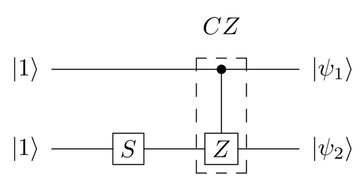
A single-qubit S gate is applied on the
bottom qubit before it’s fed to the target
of the CZ gate. So, this circuit
contains the single-qubit S gate
coupled with the two-qubit CZ gate.
In other words, you end up with a situation where you
have to deal with the ![]() matrix
for the S gate as well as the
matrix
for the S gate as well as the
![]() matrix for the CZ
gate.
matrix for the CZ
gate.
To apply the matrix method to calculate the quantum states of the qubits in this circuit, the matrices need to be compatible so that they can be multiplied. For square matrices, this means that the matrices must have the same dimensions.
Thus, the single-qubit S gate is “made” into a two-qubit gate by appending the second qubit, the top one in this case, as a pass-through, as shown in the following figure:[44][45]
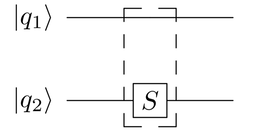
Next, use the single-qubit S gate’s
![]() matrix as a guide to calculate
the matrix for the two-qubit S gate.
For reference, the matrix
matrix as a guide to calculate
the matrix for the two-qubit S gate.
For reference, the matrix ![]() for the
S Gate, is:
for the
S Gate, is:

Notice that this matrix implies that the pentagon
![]() qubelets are unaffected,
while the triangle
qubelets are unaffected,
while the triangle ![]() qubelets
are rotated by
qubelets
are rotated by ![]() radians, or 90°
anticlockwise:
radians, or 90°
anticlockwise:

The angle ![]() indicates the relative difference
between the pentagon
indicates the relative difference
between the pentagon ![]() and
triangle
and
triangle ![]() qubelets.
qubelets.
As we did for the CNOT
gate earlier in this section, work out the columns
of the ![]() matrix by seeing what
this circuit does to each of the four idealized states,
matrix by seeing what
this circuit does to each of the four idealized states,
![]() ,
, ![]() ,
,
![]() , and
, and
![]() :
:
 Idealized State:
Idealized State:-
The top qubit,
 ,
is a pass-through. So it’s unchanged
by the gate.
,
is a pass-through. So it’s unchanged
by the gate.
The bottom qubit,
 ,
is fed to the S gate. From this gate’s
matrix,
,
is fed to the S gate. From this gate’s
matrix,  , the bottom
, the bottom  qubit, is also unaffected.
qubit, is also unaffected.
Thus,
 .
Write the latter state as a vector:
.
Write the latter state as a vector:
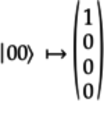
Note that the first element of this vector is associated with
 .
.
 Idealized State:
Idealized State:-
The top qubit,
 ,
is a pass-through. So, it’s unchanged by the
gate.
,
is a pass-through. So, it’s unchanged by the
gate.
The bottom qubit,
 ,
becomes
,
becomes  when acted on
by the S gate in accordance with the
gate matrix
when acted on
by the S gate in accordance with the
gate matrix  . Thus,
. Thus,
 .
Write the latter state as a vector:
.
Write the latter state as a vector:

The second element, associated with
 ,
is
,
is  .
.
 Idealized State:
Idealized State:-
The top qubit,
 ,
is a pass-through. So it’s unchanged by the
gate.
,
is a pass-through. So it’s unchanged by the
gate.
The bottom qubit,
 ,
is fed to the S gate and is unchanged
in accordance with the gate matrix
,
is fed to the S gate and is unchanged
in accordance with the gate matrix  .
Thus,
.
Thus,  .
Write the latter state as a vector:
.
Write the latter state as a vector:

The third element is associated with
 .
.
 Idealized State:
Idealized State:-
The top qubit,
 ,
is a pass-through. So it’s unchanged by the
gate.
,
is a pass-through. So it’s unchanged by the
gate.
The bottom qubit,
 ,
becomes
,
becomes  when acted on
by the S gate in accordance with the
gate matrix
when acted on
by the S gate in accordance with the
gate matrix  . Thus,
. Thus,
 .
Write the latter state as a vector:
.
Write the latter state as a vector:
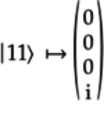
These vectors then form the columns of the
![]() matrix for the pass-through
two-qubit S gate:
matrix for the pass-through
two-qubit S gate:
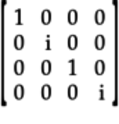
Now, the matrices for both the pass-through
S gate and the CZ gate
are the same size. Thus, you can multiply their
matrices to get how these gates act on
![]() :
:
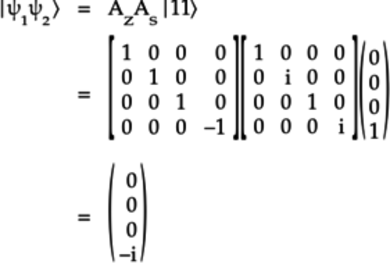
Notice that the order of multiplying the matrices
![]() and
and ![]() is opposite to the order in which the
corresponding gates are applied to the input state
is opposite to the order in which the
corresponding gates are applied to the input state
![]() . Also, the input state
. Also, the input state
![]() is replaced with its
vector in the previous equation.
is replaced with its
vector in the previous equation.
The multiplication of the matrices with the vector
for ![]() results in the
quantum state
results in the
quantum state ![]() :
:
Once again, to convince yourself that the matrix
procedure gives the correct result, you can reason
this circuit out manually: the S gate
on the bottom qubit, ![]() , rotates
its triangle
, rotates
its triangle ![]() qubelet by
qubelet by
![]() radians, or a quarter turn anticlockwise.
Since, the control qubit to the
CZ gate is
radians, or a quarter turn anticlockwise.
Since, the control qubit to the
CZ gate is ![]() ,
the CZ gate will rotate the
triangle
,
the CZ gate will rotate the
triangle ![]() qubelet on the
target qubit on the bottom by
a half turn. So, the triangle
qubelet on the
target qubit on the bottom by
a half turn. So, the triangle ![]() qubelet will end up rotated a quarter turn clockwise,
or
qubelet will end up rotated a quarter turn clockwise,
or ![]() radians, as shown in the figure.
radians, as shown in the figure.

Analyzing existing circuit designs is useful to pick up ways to work with qubits. But eventually you’ll want to twist qubelets in ways unique to your application. So in the next section, you’ll learn how matrices also help to identify the gates you’ll need in your own designs.
The circuits in this section were initialized with idealized states. In the next section, you’ll learn to work with circuits seeded with blended states obtained as a result of a previous computation.
